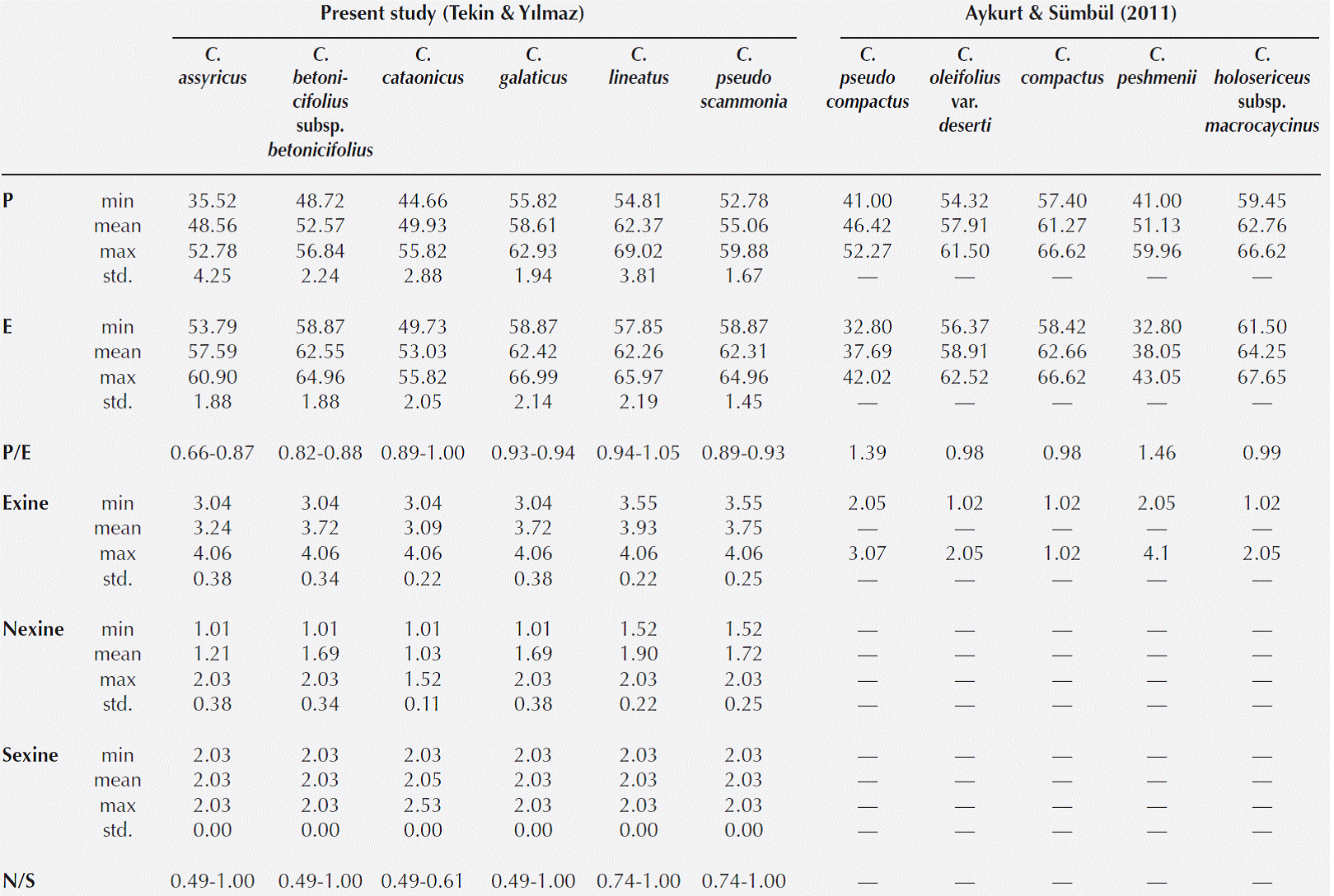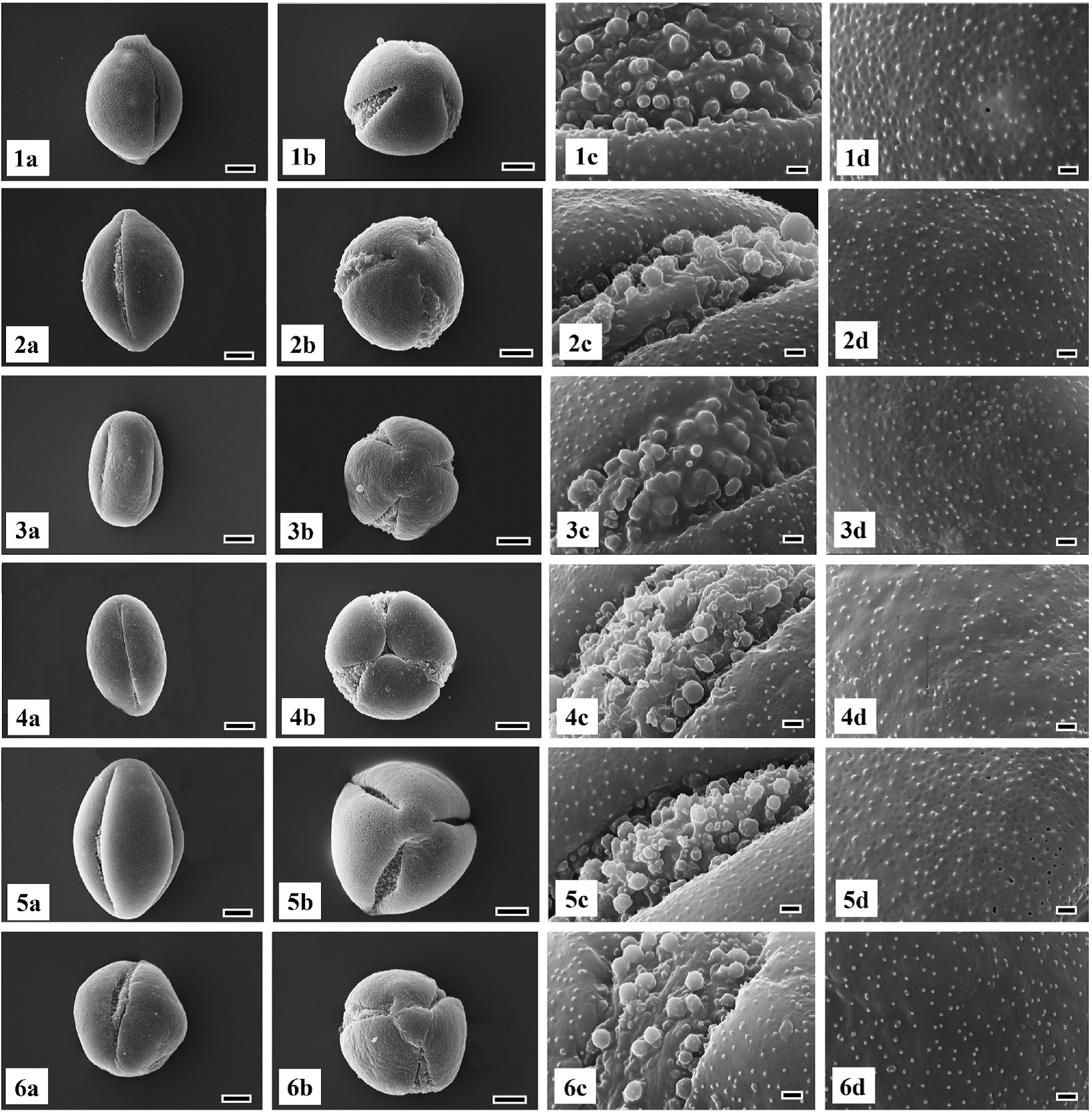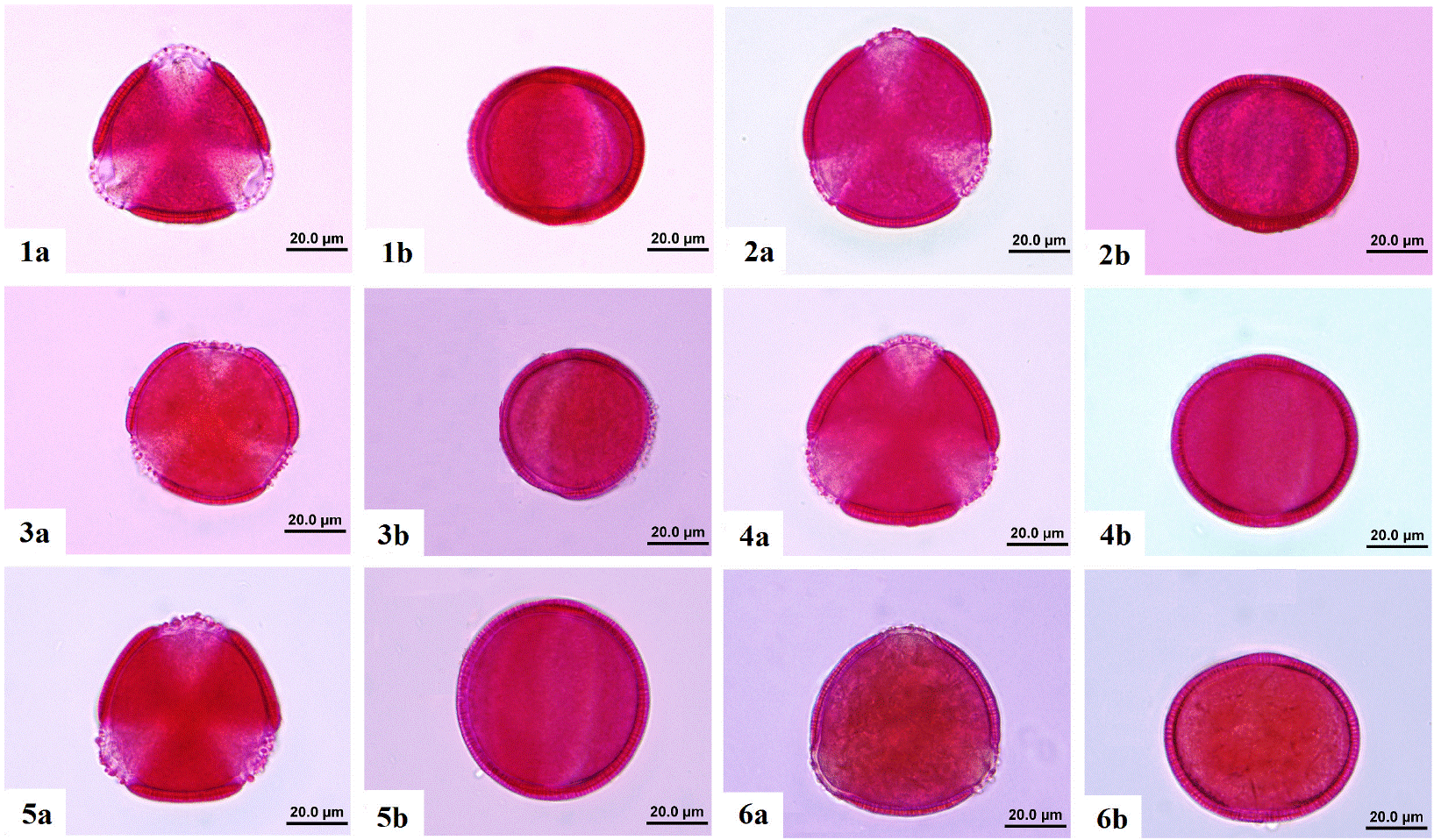The family Convolvulaceae Juss. is represented by 56 genera and approximately 1,600 species worldwide (Simpson, 2006). Convolvulus L. is the second largest genus in the family, with about 250 species (Cronquist, 1981). Pollen morphology of some taxa of the family was examined first by Hallier (1893), who divided the family into two main groups, Psiloconiea and Echinoconiea, on the basis of pollen morphology. The group Psiloconiea consisted of psilate or granulate pollen grains while group Echinoconiea consisted of pollen grains with echinate exine ornamentation. The family was also divided into two groups by Gamble (1923) on the basis of spinulose or non-spinulose apertural types. According to the classification of Gamble (1923), Convolvulus was situated in the non-spinulose group. Based on these classifications, Erdtman (1952) divided the pollen grains of Convolvulaceae, into ‘‘Ipomea type’’ and ‘‘other types’’, and incorporated the genus Convolvulus into the latter group. The genera of Convolvulaceae were separated by O’Donell (1959) according to Hallier’s aperture distinction, but at the same time he stated that pollen grains of the genus Convolvulus have the 3-colporate pollen type. Lewis and Oliver (1965) reported results that supported the findings of Hallier (1893), but not those of O’Donell (1959). Sengupta (1972) reported an exhaustive palynological investigation on the Convolvulaceae based on the number and dispersion of apertures. He divided the family into four main pollen types and grouped Convolvulus in the tricolpate type, as distinct from the results of O’Donell (1959).
Convolvulus species are mainly distributed in the temperate and tropical regions of the world. The number of Convolvulus taxa recognized for Turkey has varied among different treatments. The ‘‘Flora of Turkey’’ recognized 32 species (36 taxa) and 3 imperfectly known species (Parris, 1978; Davis et al., 1988). According to Aykurt (2010), there are 35 Convolvulus species (three of them hybrids) distributed in Turkey. Güner et al. (2012) reported 35 species of the genus and 39 taxa. The taxonomy and pollen morphology of the genus Convolvulus in Turkey was studied by Aykurt (2010) and Aykurt & Sümbül (2011). The aim of this study is to document for the first time the pollen features of six Convolvulus taxa growing in Turkey: Convolvulus assyricus Griseb., C. betonicifolius Mill. subsp. betonicifolius, C. cataonicus Boiss. & Hausskn., C. galaticus Rost. ex Choisy, C. lineatus L., and C. pseudoscammonia K. Koch.
Material and methods
Pollen samples were obtained from specimens housed in the Faculty of Science Herbarium (CUFH), Cumhuriyet University, Sivas province, Turkey (Table 1). Pollen grains obtained from mature anthers were prepared following Wodehouse (1965). Observations and measurements were made from prepared materials of 30 pollen grains per species on an Olympus optical microscope CX21 (Tokyo, Japan) with an immersion objective lens (100×) and an ocular scale (10×). For the measurements, 1 ocular division was equivalent to 1.015 µm. In addition, the ornamentation and the structure of the pollen grains were determined. The pollen images were taken with an Olympus DP 70 digital camera (Tokyo, Japan) fitted on an Olympus BX51optical microscope (Tokyo, Japan). Statistical analyses were performed with the SPSS package program (ver. 15) on the results of the palynological measurements given in Table 2. For study with scanning electron microscopy (SEM), the pollen grains taken from the anther were transferred to stubs that were previously prepared with double-sided adhesive tape. The stubs were then coated with gold for 5 minutes. The surface ornamentation detail and the aperture characteristics of the pollen grains were investigated under an LEO 440 scanning electron microscope, and microphotographs were taken at different magnifications for each species. The terminology used in this study follows Punt et al., (1994).
Table 2 The palynological measurement results of Convolvulus taxa examined in this study and their comparisons with the study of Aykurt & Sümbül (2011) [minimum (min), maximum (max), arithmetic mean (mean), standard deviation (std.), polar diameter (P), equatorial diameter (E), P/E ratio (P/E), exine thickness (Ex), nexine thickness (N), sexine thickness (S) N/S ratio (N/S), Measurements are given in μm]

Results
In this study, pollen grains of the Convolvulus species examined are 3-zonocolpate. The shape of the pollen grains are oblate, suboblate, oblate spheroidal or prolate spheroidal. For all examined species, nexine is thinner than the sexine or equal (Table 2). The SEM study showed that the tectum is microechinate and rarely or densely perforate in all examined species, with the exception of C. pseudoscammonia, which has only a microechinate tectum surface. Perforations are approximately circular (Figure 1). Palynological measurements and observations of each species are given in Table 2.

Figure 1 Palynological micrographs taken with an SEM microscope. 1) Convolvulus assyricus; 2) C. betonicifolius subsp. betonicifolius; 3) C. cataonicus; 4) C. galaticus; 5) C. lineatus; 6) C. pseudoscammonia; a. equatorial view; b. polar view; c. detail of aperture; d. exine ornamentation (Scale bars 10 μm in a,b; 1μm in c,d)
Descriptions of pollen grains
1. Convolvulus assyricus
Pollen type: 3-zonocolpate, Pollen shape: oblate or suboblate, Apertures: colpi borders and tapering ends distinct and colpus area gemmate and granulate. Exine structure: tectate, microechinate, tectum rarely perforate, perforations approximately circular, irregularly distributed, sexine thicker than nexine or equal (Figure 1; Figure 2; Table 2).

Figure 2 Palynological micrographs taken with an optical microscope. 1) Convolvulus assyricus; 2) C. betonicifolius subsp. betonicifolius; 3) C. cataonicus; 4) C. galaticus; 5) C. lineatus; 6) C. pseudoscammonia; a. optical section in polar view; b. optical section in equatorial view
2. Convolvulus betonicifolius subsp. betonicifolius
Pollen type: 3-zonocolpate, Pollen shape: suboblate, Apertures: colpi borders and tapering ends distinct and colpus area gemmate and granulate. Exine structure: tectate, microechinate, tectum densely perforate, perforations approximately circular, irregularly distributed, sexine thicker than nexine or equal (Figure 1; Figure 2; Table 2).
3. Convolvulus cataonicus
Pollen type: 3-zonocolpate, Pollen shape: oblate-spheroidal, Apertures: colpi borders and tapering ends distinct and colpus area gemmate and granulate. Exine structure: tectate, microechinate, tectum rarely perforate, perforations approximately circular, irregularly distributed, sexine thicker than nexine (Figure 1; Figure 2; Table 2).
4. Convolvulus galaticus
Pollen type: 3-zonocolpate, Pollen shape: suboblate or oblate-spheroidal, Apertures: colpi borders and tapering ends distinct and colpus area gemmate and granulate. Exine structure: tectate, microechinate, tectum rarely perforate, perforations approximately circular, irregularly distributed, sexine thicker than nexine (Figure 1; Figure 2; Table 2).
5. Convolvulus lineatus
Pollen type: 3-zonocolpate, Pollen shape: oblate-spheroidal or prolate spheroidal, Apertures: colpi borders and tapering ends distinct and colpus area gemmate and granulate. Exine structure: tectate, microechinate, tectum densely perforate, perforations approximately circular, irregularly distributed, sexine thicker than nexine or equal (Figure 1; Figure 2; Table 2).
6. Convolvulus pseudoscammonia
Pollen type: 3-zonocolpate, Pollen shape: oblate-spheroidal, Apertures: colpi borders and tapering ends distinct and colpus area gemmate and granulate. Exine structure: tectate, microechinate, sexine thicker than nexine or equal (Figure 1; Figure 2; Table 2).
Discussion
Convolvulaceae is an eurypalynous family (Lewis and Olivier, 1965). However the pollen grains of the genus Convolvulus are not very different, and there is little variation between species. Therefore, Convolvulus is a stenopalynous genus (Perveen et al., 1989). The present study supports this view and showed that all six Convolvulus species have radial symmetrical and isopolar pollen grains.
The shape of pollen grain is oblate or suboblate in Convolvulus assyricus, suboblate in C. betonicifolius subsp. betonicifolius, oblate spheroidal in C. cataonicus and C. pseudoscammonia, suboblate or oblate spheroidal in C. galaticus and oblate spheroidal or prolate spheroidal in C. lineatus. Aykurt and Sümbül (2011) studied pollen morphology of five other Convolvulus taxa (C. pseudocompactus Aykurt & Sümbül, C. oleifolius Desr. var. deserti Pamp., C. compactus Boiss., C. peshmenii Aykurt & Sümbül, and C. holosericeus M. Bieb. subsp. macrocalycinus Hausskn. & Bornm. ex Bornm.) distributed in Turkey. Comparison of the results between their study and this study are given in Table 2. According to Aykurt and Sümbül (2011) all Convolvulus species are tricolpate, with the exception of C. oleifolius var. deserti, which sometimes has tetracolpate pollen grains and pollen shape varies from spheroidal to spheroidal subprolate and prolate. However, according to Aykurt and Sümbül (2011) the ornamentation type of all five taxa is microechinate-perforate. The aperture type of all species examined in this study are 3-zonocolpate and ornamentation types are microechinate, with rarely or densely perforate sculpturing. However, pollen grains of C. pseudoscammonia do not have perforations on the exine surface, and that is an important distinction between the examined species.
According to Parris (1978), of these six Convolvulus species, C. pseudoscammonia is the most distinct morphologically. Results of this study support that, as in morphology, there are important differences in pollen ornamentation between C. pseudoscammonia and the other five examined species. Perveen et al. (1989) grouped the pollen grains of 22 West Asian and Arabian Peninsula Convolvulus species into four different pollen types which they recognized on the basis of exine ornamentation: Type I- Coarsely reticulate type; Type II- Medium reticulate type; Type III- Finely reticulate/punctuate-scabrate type; Type IV- Sparsely punctuate-scabrate type. They grouped 13 out of a total of 22 species in Type III, which is the major group. In the present survey, if we grouped the examined Convolvulus taxa according to Perveen et al. (1989), we can incorporate C. assyricus, C. betonicifolius subsp. betonicifolius, C. cataonicus, C. galaticus and C. lineatus into Type IV which have sparcely punctate pollen grains. In our study we use the terminology of Punt et al. (1994), so that instead of punctuate-scabrate, we used perforate-microechinate. Pollen grains of C. pseudoscammonia have not perforation on the exine surface. Thus, in contrast to all other examined species, C. pseudoscammonia could not be included in the classification of Perveen et al. (1989).
Among the studied species, C. assyricus is an endemic for the flora of Turkey and is morphologically very similar to C. compactus (Parris, 1978). When we consider the results of present study and that of Aykurt and Sümbül (2011), we concluded that the variations of the pollen grains between C. assyricus and C. compactus are very obvious and that they can be used to distinguish between these two species. In our study, the P/E ratio of C. assyricus pollen grains varied between 0.66-0.87 and accordingly pollen shape is oblate or suboblate. According to Aykurt and Sümbül (2011), the P/E ratio of C. compactus pollen grains is 0.98 and pollen shape is spheroidal. Another important palynological difference between the two species is exine thickness. While exine is very thick in C. assyricus, varying from 3.04-4.06 µm, exine of C. compactus pollen grains is very thin, 1.02 µm (Table 2). With these two distinctive palynological features, the morphologically similar species C. assyricus and C. compactus are easily separable from each other. In the future, with the determination of the pollen morphology of other Convolvulus taxa from Turkey, this study will contribute to the comparison of the pollen morphology of all members of the genus Convolvulus. In this study, pollen morphology of six Convolvulus species, three of them endemic to Turkey, were studied in detail for the first time. The results were compared with those from previous studies of different species of the same genus. In addition, significant differences are reported between some Convolvulus species that are morphologically very similar, and thus they can be separated easily from each other based on their pollen.











 nova página do texto(beta)
nova página do texto(beta)



